A woman’s dress is a unique cultural artifact that provides glimpses into specific cultural identities1. Historically, Idaho women’s clothing was marked with practicality; structure and function were paramount to the fashion trends of the 19th century. The wedding dresses displayed in this digital exhibit provide unique insights into Idaho women’s cultural tradition. These dresses, although they are cut to accommodate the modest fashions of the 19th century possess a color and style that was more practical for life on the American frontier.
For more than half of the 19th century Great Britain, and more specifically Queen Victoria, set the trend in both societal customs and fashions. In fact, the years between about 1840 and the turn of the 20th century are referred to as the Victorian era. During this span of time Victorianism spread throughout Great Britain and much of the United States. Victorianism is most commonly thought of as a set of rather strict values, a kind of social-moral code to follow — obsessively concerned with modesty and propriety. By being so obsessed with modesty Victorianism also had a distinct fashion trend that lasted throughout the era2.
Victorian women’s fashion consisted of dresses with high necklines, often rising above the collarbones, sleeves reaching to the wrists and full-length skirts grazing the ground and adding several pounds to the garment. Nearly every part of a proper Victorian woman’s body should have been covered, especially the entirety of her legs3. The bodice and sleeves of Victorian dresses were tightly fitted to the body of the woman wearing it4. Corsets were worn underneath dresses in order to create an illusion of a tiny, hourglass waist, a prominent body modification trend of the 19th century. Another typical style of the 19thcentury came with the development of the bustle.
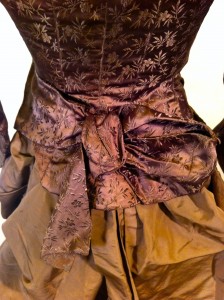
Notice the decorative bow atop the mounds of fabric, containing a wire cage-like structure underneath: the bustle. Image courtesy of Idaho State Historical Society. Catalog # 1989.06.03/1-2
The bustle consisted of fabric, bunched up and draped to accentuate the hips of the dress wearer. The bustle eventually lost popularity because of the difficulty of execution in dressmaking. While still Western in structure, all of the dresses in this exhibit have some qualities of Victorian trends.
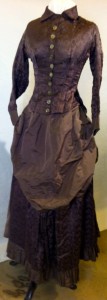
Notice the tightly fitted bodice and conservative skirt and sleeve lengths, as well as the high collar. Image courtesy of Idaho State Historical Society. Catalog # 1989.06.03/1-2
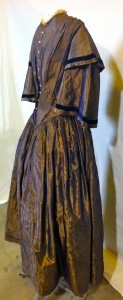
Pagoda sleeves were a popular trend as Queen Victoria's wedding dress had similar pagoda-style sleeves. Image courtesy of Idaho State Historical Society. Catalog # 1988.81.1
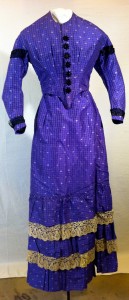
A conservative jacket covers the short-sleeved bodice of this dress, meaning the dress could have been worn during all seasons of the year. Image courtesy of Idaho State Historical Society. Catalog # 1971.119.3/1-3
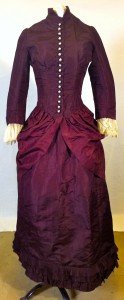
This dress is a classic Victorian style, with long sleeves, a high collar and excess fabric at the hips to cover the bustle on the back of the dress. Image courtesy of Idaho State Historical Society. Catalog # 1975.25.2/1-2

This dress is a perfect example of a western style -- yet still Victorian -- dress. It follows the modest guidelines of Victorian fashion while accomodating to the earthy colors of the western frontier. Image courtesy of Idaho State Historical Society. Catalog # 935 C
ENDNOTES
1. Nancy Micklewright, Late-Nineteenth-Century Ottoman Wedding Costumes as Indicators of Social Change (BRILL: Leiden, 1989) 161.
2. Kelly Boyd and Rohan McWilliam. Victorian Studies Reader (New York: Routledge, 2007).
3. Chris Ingraham. White Weddings: Romancing Heterosexuality in Popular Culture (New York: Routledge, 2007).
4. Ingraham, White Weddings.